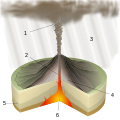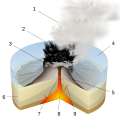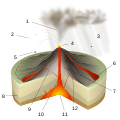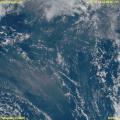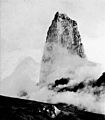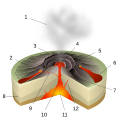
Back بوابة:براكين Arabic Portal:Vulkane German Portail:Volcanisme French 포털:화산 Korean Portal:Vulcões Portuguese Портал:Вулканы Russian Portal:Vulqonlar Uzbek Portal:火山 Chinese
The Volcanoes portal

A volcano is a rupture in the crust of a planetary-mass object, such as Earth, that allows hot lava, volcanic ash, and gases to escape from a magma chamber below the surface. The process that forms volcanoes is called volcanism.
On Earth, volcanoes are most often found where tectonic plates are diverging or converging, and because most of Earth's plate boundaries are underwater, most volcanoes are found underwater. For example, a mid-ocean ridge, such as the Mid-Atlantic Ridge, has volcanoes caused by divergent tectonic plates whereas the Pacific Ring of Fire has volcanoes caused by convergent tectonic plates. Volcanoes can also form where there is stretching and thinning of the crust's plates, such as in the East African Rift, the Wells Gray-Clearwater volcanic field, and the Rio Grande rift in North America. Volcanism away from plate boundaries has been postulated to arise from upwelling diapirs from the core–mantle boundary, 3,000 kilometers (1,900 mi) deep within Earth. This results in hotspot volcanism, of which the Hawaiian hotspot is an example. Volcanoes are usually not created where two tectonic plates slide past one another.
Large eruptions can affect atmospheric temperature as ash and droplets of sulfuric acid obscure the Sun and cool Earth's troposphere. Historically, large volcanic eruptions have been followed by volcanic winters which have caused catastrophic famines.
Other planets besides Earth have volcanoes. For example, volcanoes are very numerous on Venus. In 2009, a paper was published suggesting a new definition for the word 'volcano' that includes processes such as cryovolcanism. It suggested that a volcano be defined as 'an opening on a planet or moon's surface from which magma, as defined for that body, and/or magmatic gas is erupted.'
This article mainly covers volcanoes on Earth. See § Volcanoes on other celestial bodies and cryovolcano for more information. (Full article...)
Selected article -
Limalok (formerly known as Harrie or Harriet) is a Cretaceous-Paleocene guyot/tablemount in the southeastern Marshall Islands, one of a number of seamounts (a type of underwater volcanic mountain) in the Pacific Ocean. It was probably formed by a volcanic hotspot in present-day French Polynesia. Limalok lies southeast of Mili Atoll and Knox Atoll, which rise above sea level, and is joined to each of them through a volcanic ridge. It is located at a depth of 1,255 metres (4,117 ft) and has a summit platform with an area of 636 square kilometres (246 sq mi).
Limalok is formed by basaltic rocks and was probably a shield volcano at first; the Macdonald, Rarotonga, Rurutu and Society hotspots may have been involved in its formation. After volcanic activity ceased, the volcano was eroded and thereby flattened, and a carbonate platform formed on it during the Paleocene and Eocene. These carbonates were chiefly produced by red algae, forming an atoll or atoll-like structure with reefs. (Full article...)Did you know
- ... that the 60 million years old Carmelo Formation (pictured) is made out of thousands of layers of volcanic pebbles, sandstone and mudstone with fossils?
- ... that one of the activities that are possible at the Nevado de Toluca National Park is scuba diving in the two volcanic crater lakes?
- ... that the Popocatépetl volcano occasionally dumps ash on the municipality of Ozumba, Mexico?
- ... that in August 2001, the Galileo spacecraft flew through the sulfur dioxide gas plume of the Ionian volcano Thor?
- ... that the Garibaldi Volcanic Belt in southwestern British Columbia is the site of Canada's largest recorded Holocene explosive eruption 2,350 years ago at the Mount Meager massif?
- ... that most of the recent volcanism in New Zealand has been along the line of the Taupo Volcanic Zone and the Kermadec island arc?
- ... that the asphalt volcano is a rare submarine volcano composed of asphalt and erupting petroleum and methane instead of lava?
- ... that eruptions from Mahogany Mountain, a caldera volcano, produced rock formations in Leslie Gulch over 15 million years ago?
General images
Selected biography -
Harry Glicken (March 7, 1958 – June 3, 1991) was an American volcanologist. He researched Mount St. Helens in the United States before and after its 1980 eruption, and was very distraught about the death of volcanologist David A. Johnston, who was Glicken's mentor and supervisor in Spring 1980 at Mount St. Helens. Glicken was initially assigned to the USGS observation post in the weeks leading up to the eruption but was called away the night before the eruption.
In 1991, while conducting avalanche research on Mount Unzen in Japan, Glicken and fellow volcanologists Katia and Maurice Krafft were killed by a pyroclastic flow. His remains were found four days later and were cremated in accordance with his parents' request. Glicken and Johnston remain the only American volcanologists known to have died in volcanic eruptions.
Despite a long-term interest in working for the United States Geological Survey, Glicken never received a permanent post there because there was a hiring freeze for federal agencies when he graduated with his PhD. While conducting research from sponsorships granted by the National Science Foundation and other organizations, Glicken accrued expertise in the field of volcanic debris avalanches. He also wrote several major publications on the topic, including his doctoral dissertation based on his research at Mount St. Helens titled "Rockslide-debris Avalanche of May 18, 1980, Mount St. Helens Volcano, Washington" that initiated widespread interest in the phenomenon. (Full article...)Selected picture
 |
Woodblock of Mount Fuji, one of a set of 36 ukiyo-e prints by Katsushika Hokusai depicting Mt. Fuji. The woodblock is titled South Wind, Clear Sky (also known as Red Fuji), and depicts Mount Fuji, Japan's most iconic volcano.
Selected quote
Related portals
WikiProjects
Volcanoes topics
Subcategories
Featured work and other approved content

Featured articles: 1980 eruption of Mount St. Helens • 2007–2008 Nazko earthquakes • Amchitka • Armero tragedy • Craters of the Moon National Monument and Preserve • Cerro Azul (Chile volcano) • David A. Johnston • Enceladus (moon) • Geology of the Lassen volcanic area • Io (moon) • Kamaʻehuakanaloa Seamount • Mauna Kea • Mauna Loa • Metacomet Ridge • Mono-Inyo Craters • Mount Cayley volcanic field • Mount St. Helens • Mount Tambora • Nevado del Ruiz • Surtsey • The Volcano (British Columbia) • Triton (moon) • Upper and Lower Table Rock • Volcanism on Io • Volcano (South Park) • Yellowstone National Park
Featured lists: List of volcanoes in Indonesia • List of volcanoes in the Hawaiian – Emperor seamount chain • List of largest volcanic eruptions
Featured pictures: There are currently 43 volcano-related Featured pictures. A full gallery can be seen here.

Good articles: Abyssal plain • Amak Volcano • Anahim hotspot • Axial Seamount • Ben Nevis • Bowie Seamount • Crater Lake • Davidson Seamount • Ferdinandea • Gareloi Volcano • Geyser • Glacier Peak • Hawaii hotspot • Hualālai • Kohala (mountain) • Lake Toba • Minoan eruption • Mount Adams (Washington) • Mount Bailey • Mount Baker • Mount Cleveland (Alaska) • Mount Edziza volcanic complex • Mount Garibaldi • Mount Hood • Mount Kenya • Mount Rainier • Mount Redoubt • Mount Tehama • Mount Thielsen • Mount Vesuvius • Peter I Island • Roxy Ann Peak • Rùm • Sakurajima • Sangay • Silverthrone Caldera • Staffa • Types of volcanic eruptions • Volcanic ash • Weh Island • Wells Gray-Clearwater volcanic field • Yamsay Mountain
Valued pictures: A gallery of volcano-related valued pictures can be seen here.
What you can do

- Add the {{WikiProject Volcanoes}} message box to talk pages of articles within the scope of this project, including appropriate assessments, if needed.
- Add appropriate volcano type categories to articles, and verify the accuracy of any existing categories. See the section "Categorization" below.
- Add {{infobox mountain}} to articles if needed and missing, and add volcano-related fields to existing infoboxes if these are missing.
- Expand volcano articles which are stubs, especially by adding photos and (most importantly) proper references.
- Help improve articles related to Hawaiian and Canadian volcanism by joining the Hawaiian and Canadian workgroups.
- Improve some of the project's most visible articles.
Associated Wikimedia
The following Wikimedia Foundation sister projects provide more on this subject:
-
Commons
Free media repository -
Wikibooks
Free textbooks and manuals -
Wikidata
Free knowledge base -
Wikinews
Free-content news -
Wikiquote
Collection of quotations -
Wikisource
Free-content library -
Wikiversity
Free learning tools -
Wiktionary
Dictionary and thesaurus
© MMXXIII Rich X Search. We shall prevail. All rights reserved. Rich X Search









